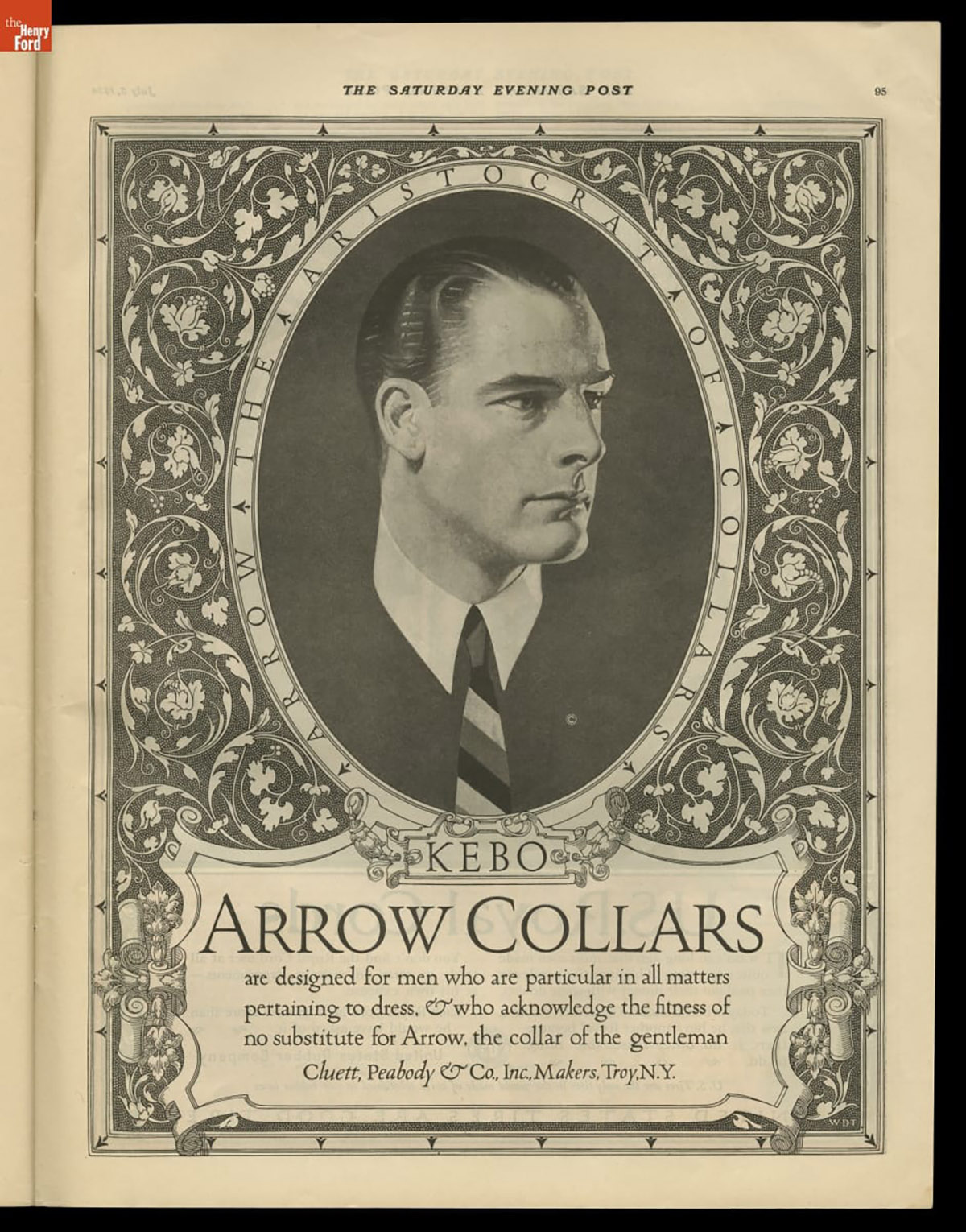J.C. Leyendecker: America’s Master Illustrator
One of the most prolific and popular artists of the early 20th century, J.C. Leyendecker created iconic advertising and magazine illustrations that made a lasting impression on American culture.

Advertisement for Arrow Collars, featuring Leyendecker’s iconic Arrow Collar Man, The Saturday Evening Post, July 5, 1924. / THF704785
Advertising
Joseph Christian Leyendecker, known as J.C., was born in 1874 in Germany. He moved with his family in 1882 to Chicago, where he studied art and entered the burgeoning field of commercial illustration. Leyendecker honed his artistic skills in Paris during the 1890s, when advertising posters by artists including Henri de Toulouse-Lautrec and Jules Chéret reached the height of their popularity.
Leyendecker relocated in 1902 to New York City. It was an advantageous time and place for a budding commercial artist, as a growing number of manufacturers sought illustrators for advertisements to help differentiate their consumer goods from the competition. Leyendecker created images that promoted a wide range of products — from Ivory soap and Gillette razors to Karo corn syrup and Kellogg’s cereal — but he made his mark in menswear. For a campaign advertising Cluett Peabody & Co.’s line of Arrow brand shirts, collars and cuffs, Leyendecker produced illustrations of handsome men who exuded style and sophistication. As the Gibson Girl had defined femininity at the end of the previous century, Leyendecker’s popular images, known collectively as the Arrow Collar Man, became a cultural phenomenon that set a new standard for men’s fashion and beauty. Cluett Peabody & Co. reportedly received piles of fan mail addressed to the Arrow Collar Man, who was referenced in popular literature, music and theater. The campaign propelled Leyendecker’s professional career and profoundly impacted his personal life. Charles Beach, an early and frequent model for Leyendecker’s Arrow collar illustrations, became his lifelong partner.

Leyendecker’s illustrations of fashionable men helped change the advertising landscape, as evidenced by this early 1920s advertisement for Chicago-based clothier B. Kuppenheimer & Co. / Detail, THF109556
The Arrow Collar Man reflected a broader shift in marketing, toward bold visuals that connected everyday products with an aspirational lifestyle. Leyendecker excelled in this, employing his trademark depictions of fashionable men in successful campaigns for a wide range of clients. His illustrations sold an idea of glamour and luxury that average consumers could only hope to experience — even if they purchased the shaving cream, suit or automobile being advertised. Leyendecker’s illustrations were widely imitated and helped change the advertising landscape. Americans encountered them everywhere.

Leyendecker’s cover for the June 4, 1904, issue of Collier’s illustrated the first article in a series highlighting outdoor sports and leisure. / THF704891
Magazines
Leyendecker’s talents translated well to the magazine format. He contributed to nearly every major national publication and was soon recognized for his cover illustrations. Leyendecker completed more than 500 magazine covers over the course of his career, including 321 for the popular weekly publication The Saturday Evening Post. His imaginative cover designs became favorites among readers, who easily picked them out from competing imagery at busy newsstands.

Leyendecker’s now-iconic depiction of Santa Claus featured on the December 20, 1930, cover of The Saturday Evening Post. / THF704790
Leyendecker’s early magazine covers illustrated stories printed within each issue, but he was soon given license to create covers around general themes of his choosing. In these images, Leyendecker both captured and helped shape the imagery of American culture — something perhaps best represented by his depictions of holiday traditions. Readers of The Saturday Evening Post looked forward to Leyendecker’s holiday covers year-round, eagerly awaiting his New Year’s babies, with their timely messages about the year to come, and wholeheartedly embracing his jolly, now-iconic Santa Claus.

Leyendecker’s World War I poster, “Weapons for Liberty,” advertising war bonds, 1917. / THF62415
Leyendecker’s Legacy
Through his advertising and magazine illustrations, Leyendecker gained renown as an artist who could tell a complete, compelling story through a single image. Recognizing this, the U.S. government called on him to create posters during both world wars, further cementing him as one of America’s best-known illustrators.
Leyendecker appealed to popular audiences and fellow artists alike. One young illustrator, Norman Rockwell, revered Leyendecker, studied his work and ultimately approached him for advice. Leyendecker, 20 years Rockwell’s senior, became a mentor and friend. His influence is evident in both the younger artist’s style and subject matter. Rockwell would overtake Leyendecker as The Saturday Evening Post’s most famous cover artist — and, arguably, become America’s most famous illustrator.

Leyendecker’s depictions of men – a marketing innovation in their own time – continue to inform visual storytelling and appeal to new generations of admirers. Collier’s illustration, June 4, 1904. / Detail, THF704894
During his lifetime, Leyendecker helped revolutionize advertising and influenced a new generation of illustrators. Well after his death in 1951, his work continues to resonate and inspire. Costume designers, video game artists and other visual storytellers, including Star Wars creator George Lucas, count Leyendecker among their influences. New scholarship examines his illustrations’ special appeal to some members of the LGBTQ+ community, who recognize and feel encouraged by their coded queer imagery. Leyendecker’s legacy endures in both the work he inspired and the audiences still touched by his illustrations.
You can explore more of Leyendecker’s work in The Henry Ford’s Digital Collections.
Saige Jedele is an associate curator at The Henry Ford.

